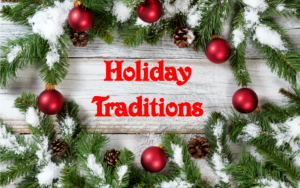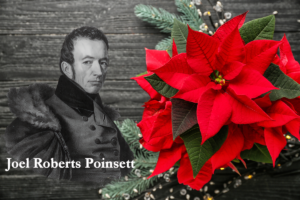Since the Christmas holiday falls on a weekend this year, let me take the opportunity to wish you an early happy holiday. As someone interested in history of all kinds, I began wondering why so much greenery is associated with this particular holiday. The staff at English Heritage observes, “Decorating our homes with greenery is a Christmas tradition ingrained in our national consciousness. The Christmas tree is, of course, the most well-known, but it is equally hard to imagine Christmas without wreaths, holly and mistletoe. But when and why did such traditions emerge?”[1] Exactly the question I asked myself. Their answer, “It’s a surprisingly difficult question to answer, as Christmas traditions are generally deep-rooted and undocumented. They have also been adapted and changed over time and are riddled with regional differences and personal interpretations.” Nevertheless, there have been attempts to uncover the origin stories of why various greenery is associated with the holiday.
Christmas Trees
By a wide margin, the most celebrated holiday greenery is the Christmas tree. According to History.com, “The history of Christmas trees goes back to the symbolic use of evergreens in ancient Egypt and Rome and continues with the German tradition of candlelit Christmas trees first brought to America in the 1800s.”[2] According to freelance writer Manasa Reddigari, not all “evergreens” were of the forest varieties we now associate with Christmas. She explains, “Ancient Egyptians decked out their homes in green palm rushes on the winter solstice to celebrate the sun god Ra’s recovery from the ills of winter, which they believed symbolized life conquering death.”[3] The evergreen trees we associate with the Christmas holiday became a tradition in Europe. Some stories credit the reformer Martin Luther with starting the tradition. Reddigari explains, “Legend has it that while walking home from the woods one winter’s night in the 16th century, Martin Luther was so moved by the sight of the stars shining above the evergreens that he recreated the shimmering spectacle at home by adding small lit candles to the branches of a fir tree he personally cut down.” That means he also started the tradition of Christmas trees catching on fire during the holidays.
According to the editors at History.com, the tradition of decorating with evergreens started much early with the Romans, the Druids, and the Vikings. They explain the Romans “decorated their homes and temples with evergreen boughs” as part of the Saturnalia feast honoring Saturn, the gold of agriculture. The Druids “also decorated their temples with evergreen boughs as a symbol of everlasting life.” And, “the fierce Vikings in Scandinavia thought that evergreens were the special plant of the sun god, Balder.” The editors agree, however, that, whether Martin Luther was involved or not, “Germany is credited with starting the Christmas tree tradition as we now know it in the 16th century when devout Christians brought decorated trees into their homes.”
Christmas Garland
The history of Christmas garland is obscure; although there seems to be a direct connection between decorating with evergreen boughs and garland. Most writers agree that the tradition of using garland at Christmas came to America from Europe. And, according to the staff at the Baker Design Group, garlands had an economic dimension as well as a religious one. They explain, “When the first settlers arrived in the US, they brought Christmas garland with them. Around the holidays, families looking to make a little extra money would take the branches of firs, pines or spruces and twist them until they became flexible, shapeable decorations. Families would then sell them to neighbors or villagers, helping them bring in a little extra income during the tough months.”[4]
Christmas Wreaths
The Christmas garlands that had the most religious meaning were Christmas wreaths — although wreaths can also be traced to pre-Christian celebrations. The staff at Santa’s Quarters explains, “The word ‘wreath’ comes from the Old English ‘writhan,’ meaning “to twist,” and over the centuries, wreaths have been associated with a variety of cultures. It’s believed that wreaths date back to the Persian Empire, ancient Egypt, and ancient Greece. … Christmas wreaths are also connected with the pagan holiday of Yule, marking the winter solstice, which was celebrated by ancient Germanic and Scandinavian peoples.”[5] They go on to explain, “Perhaps the most widespread and well-known use of wreaths comes in connection with Christmas and with Christianity, as their circular shape is said to symbolize eternal life and the unending love of God. In the 16th century, the use of wreaths during Yule was adopted by Christians and became a custom in the form of Advent wreaths. These wreaths were traditionally made of evergreens, which also symbolize eternal life, holly oak, and red berries. The red berries and the thorny leaves of the holly oak represented the crown of thorns worn by Jesus and the drops of blood that they drew.”
Holly and Ivy
A famous Christmas carol by Andrew Peterson, begins, “The holly and the ivy, when they are both full grown, of all trees that are in the wood, the holly bears the crown.” As noted above, because of its prickly nature, holly was often used in Christmas wreaths to symbolize the crown of thorns placed on Christ’s head during his crucifixion. However, journalist and historian Natasha Sheldon insists that interpretation was adopted into Christian celebrations from a much older tradition celebrating the pagan King of Winter. She explains, “[Holly] has nothing to do with Christmas. In fact, holly was the symbol of another, pagan king; the holly king who at midwinter battled with the oak king of the fading summer season — and won. Despite being a symbol of winter, the vibrant red and green of holly was also a potent symbol of life, as vivid colors stood out in the darkness of the midwinter season.”[6] Today, turning a pagan symbol into a Christian symbol might be called cultural appropriation.
Peterson’s marriage of holly and ivy in his carol is not original. Sheldon reports, “In carols older than ‘The Holly and the Ivy,’ Ivy was depicted as sad and female while the holly was vibrant and male. ‘Holy and hys mery men, they dawnseyn and they syng, Ivy and hur maydyns, they wepen and they wryng,’ lamented an ancient carol recorded in Hone’s 1823 Ancient Mysteries Described. The qualities of life and death and warmth and cold, as epitomized by these rhymes, seem to suggest holly and ivy together were an ancient epitome of the fight for survival in the midst of the cold and darkness of winter.” The staff at Altogether Christmas adds, “The use of ivy during winter goes back thousands of years. The fact that ivy, like some hollies, stayed green throughout the year led some to believe it had magical properties and led to its use as home décor in the winter months. It too, symbolized eternal life, rebirth and the spring season. In some cultures, ivy was a symbol of marriage and friendship, perhaps due to its tendency to cling.”[7]
Mistletoe
Agriculture journalist Brian Barth (@BrianJBarth) marvels at the enduring romance of mistletoe — a parasite named after bird poop. He reports, “The English word for the plant is derived from a defunct Anglo-Saxon dialect. Apparently, having noticed that mistletoe often sprouts from bird droppings on tree branches, the words for dung — ‘mistel’ — and twig — ‘tan’ — were conjoined, and the mashup ‘misteltan’ evolved over time into ‘mistletoe’.”[8] He elaborates, “Mistletoe is definitely not your typical shrub — it’s a parasite that attacks living trees. Technically, mistletoes — there are over 1,000 species found throughout the world to which botanists ascribe the name — are actually hemi-parasites. This means they obtain a portion of their energy through photosynthesis, and the rest is extracted from other plants. … But the species most commonly associated with European-based mistletoe mythologies (like kissing beneath it on Christmas) are typically found on large deciduous trees, like oaks.”
According to Barth, mistletoe’s addition to Christmas greenery came late to the game. “Historians are fuzzy on the matter,” he writes, “but it seems that mistletoe’s association with fertility and ritual and wintertime slowly morphed into the modern Christmas tradition. It makes sense that mistletoe, with its evergreen foliage and attractive red berries, would be brought indoors as decoration during the barren winter months, just as people do with fir boughs and holly branches. It is believed that by the 18th century, kissing under the mistletoe at Christmas time was a fairly widespread tradition, though the first clear historical reference comes from 1820 when Washington Irving, author of Sleepy Hollow and The Headless Horseman, wrote of the plant: ‘the mistletoe, with its white berries, hung up, to the imminent peril of all the pretty housemaids.'”
Whether or not you have made your abode festive with greenery, I hope you have the merriest and happiest of holidays this year.
Footnotes
[1] Staff, “A Short History of Christmas Greenery,” English Heritage.
[2] Staff, “History of Christmas Trees,” History.com, 8 December 2021.
[3] Manasa Reddigari, “20 Surprising Stories Behind Popular Christmas Decorations,” Bob Vila website.
[4] Staff, “The History of the Christmas Garland,” Baker Design Group, 15 May 2020.
[5] Staff, “The Origins of Christmas Wreaths,” Santa’s Quarters.
[6] Natasha Sheldon, “16 Pagan Christmas Traditions that People Mistakenly Credit to Christianity,” History Collection, 16 December 2018.
[7] Staff, “The History of Holly & Ivy,” Altogether Christmas.
[8] Brian Barth, “Oh, Ho, the Mistletoe…Is Actually a Parasite,” Modern Farmer, 20 December 2017.





